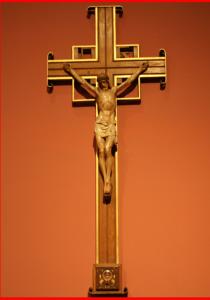Our Sad Times - Relic of the True Cross Stolen
Archdiocese prays for its recovery

A janitor at the Cathedral of the Holy Cross entered the church’s Blessed Sacrament Chapel early one recent morning and made a startling discovery: A thief had pried open a panel covering a small glass case and stolen a small piece of wood venerated by Catholics as a fragment of the cross on which Jesus was crucified.
The relic, one of the oldest and most treasured possessions of the Catholic Archdiocese of Boston, has not been seen since, and now on the wall in the dim chapel hangs a cross with its base pried open and an empty cavity where the relic once rested.
“We are deeply troubled that this sacred relic was stolen, and we pray for those responsible,’’ the Rev. Kevin J. O’Leary, rector of the cathedral, said yesterday. “We ask the faithful of the Archdiocese of Boston to join the cathedral’s parishioners in praying every day for its return.’’
The relic disappeared sometime between 10 a.m. on June 30 and 8 a.m. on July 1, according to a police report. The theft was re ported Sunday by The Lady in the Pew, a blog written by Kelly Thatcher, who describes herself as “a Roman Catholic lady who loves being a Roman Catholic lady.’’ The theft was confirmed to the Globe yesterday by the Archdiocese of Boston.
Lieutenant Detective Michael Conley said police believe that the relic was stolen by someone who visited the chapel during the day because there were no signs of forced entry. The relic, he said, was last seen by a church official at 10 a.m. June 30. Nothing else was missing from the chapel, he said.
“Somebody knew what it was,’’ he said.
He said investigators are scouring eBay to see if the relic might turn up. Last night, a Globe search of eBay found a dozen items under a search for “true cross relic,’’ with price tags ranging from $105.49 to $3,800.
The relic arrived in Boston in the late 18th century, a gift to a French missionary priest, the Rev. Jean-Louis Lefebvre de Cheverus, who later became the first bishop of Boston.
The relic was given to Cheverus by Abbe Claude de la Poterie, the first pastor of the cathedral, who was also a French priest, as well as a onetime chaplain in the French Navy.
De la Poterie celebrated the first public Mass in Boston on Nov. 2, 1788.
The relic is one of many around the world that are said to be parts of the “True Cross.’’ Churches have professed to have relics of the cross since the fourth century; the authenticity is often disputed, but the relics are nonetheless significant objects of prayer for many Catholics.
“The relic of the True Cross is an important sacramental that helps Christians contemplate the crucified Savior and the great suffering He endured for the salvation of the world,’’ said archdiocesan spokesman Terrence C. Donilon.
Boston’s first Catholic church, completed on Franklin Street in 1803, was named the Church of the Holy Cross.
The church was designated a cathedral in 1808, when the Diocese of Boston was established; the current cathedral, on Washington Street in the South End, was completed in 1875.
The north transept window at the cathedral depicts the legendary discovery of the cross by Helena, mother of the emperor Constantine. In the scene, a dead woman is restored to life after the cross is laid upon her.
The south transept window depicts another story associated with the cross: return of the relic to Jerusalem by a Byzantine emperor after it was stolen by the Persian army in the seventh century.
On a day-to-day basis, people visiting the chapel often stop to pray before the relic, said the Rev. Jonathan Gaspar, an aide to Cardinal Sean P. O’Malley. Yesterday at midday, a lone man stood in the chapel, praying.
“What they’re doing many a time is they are uniting their own suffering, their own darkness, to the suffering of Christ, in the hope that through Christ’s power and mediation, they will have light and experience the glory, even in this life, of the resurrection,’’ Gaspar said.
On Good Friday, the cross that holds the relic is brought into the cathedral, and people are invited to come forward and venerate the cross by genuflecting and kneeling in remembrance of the sacrifice of Jesus, Gaspar said.
“When a bishop comes forward to venerate the cross on Good Friday, the Ceremonial of Bishops [the book of liturgical instruction for bishops] suggests that he come to venerate without the zucchetto [the bishop’s skull cap] and without shoes,’’ Gaspar said.
“He comes forward to venerate the cross as the Emperor Heraclius did, barefoot and bareheaded.’’









0 Comments:
Post a Comment
Subscribe to Post Comments [Atom]
<< Home